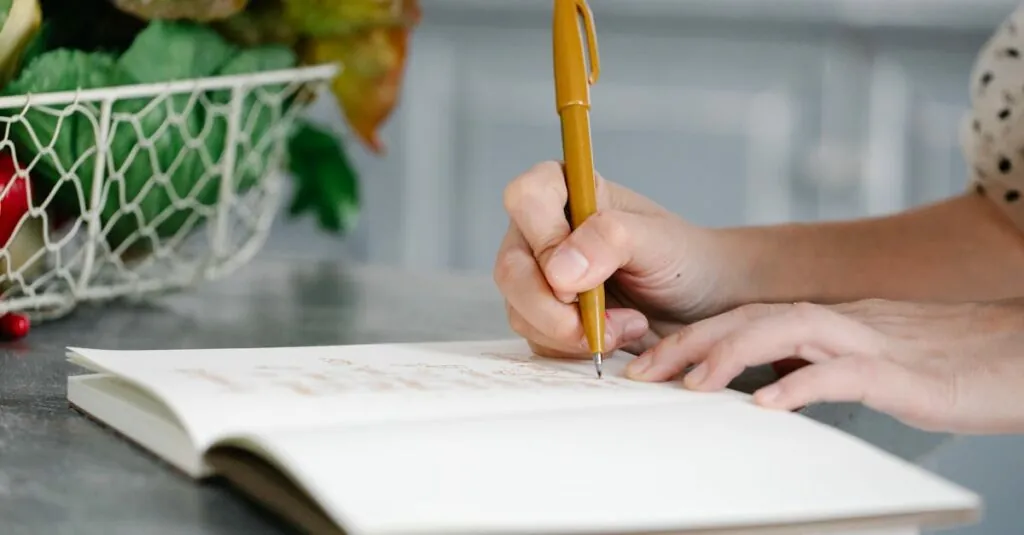Table of Contents
ToggleTransforming a kitchen countertop might seem daunting, but it doesn’t have to be. With a little creativity and elbow grease, anyone can turn a drab surface into a stunning centerpiece that’ll make guests gasp and your in-laws jealous. Who knew that DIY could be the secret ingredient to a kitchen upgrade?
Whether it’s a chic butcher block or a sleek concrete finish, crafting your own countertop can save money and give you bragging rights for years to come. Plus, you’ll have a great story to share at parties—because who wouldn’t want to hear about the time someone almost lost a finger to a power saw? Get ready to roll up those sleeves and dive into the world of DIY kitchen countertops, where the only limit is your imagination (and maybe your budget).
Overview of DIY Kitchen Countertops
DIY kitchen countertops offer an exciting way to transform kitchen spaces. Various materials, including wood, laminate, and concrete, can meet different aesthetic and budgetary needs. Techniques used vary widely, allowing homeowners to express their unique style.
Assessing the kitchen space beforehand is crucial. Measurements and layout determine the right size and shape for the countertop. Popular methods include refinishing existing surfaces, building from scratch, or repurposing materials for an eco-friendly option.
Researching materials and techniques boosts project success. Each material has distinct characteristics that influence durability, maintenance, and appearance. For example, wood provides warmth but requires more upkeep, while laminate offers an easier-to-clean surface.
Cost savings represent another advantage of DIY projects. Labor costs diminish significantly when homeowners take on the installation themselves. Tools such as saws, clamps, and sanders may incur upfront costs but save money long term.
Gathering inspiration helps make informed decisions. Online platforms and home improvement stores showcase design ideas and tutorials. Consulting with experienced DIY enthusiasts fosters creativity and can prevent common pitfalls.
Planning ensures a smooth execution. Choosing the right finish affects the final look—stains, paints, or sealants play key roles in appearance and longevity. Time estimates vary based on material and technique used, so budgeting time is essential.
Ultimately, DIY kitchen countertops allow personalization and creativity. Homeowners can create stunning surfaces that reflect their tastes and enhance their kitchens without extensive professional help. Embracing this rewarding challenge can lead to beautiful, functional results.
Materials for DIY Kitchen Countertops
Choosing the right materials is essential for a successful DIY kitchen countertop project. Various options cater to different styles and budgets.
Popular Materials
Wood remains a favorite for its warmth and versatility. Homeowners can select from hardwoods like oak or cherry, providing durability and aesthetic appeal. Laminate offers a cost-effective solution with a wide range of colors and patterns, mimicking the look of natural materials. Concrete has gained traction for its modern vibe, allowing for customization with stains and finishes. Reclaimed materials introduce sustainability while adding character to the kitchen. Each material significantly impacts the countertop’s look and functionality.
Cost Comparison
Considering budget is vital when choosing materials. Wood can range between $30 to $100 per square foot, depending on the type. Laminate usually costs less, averaging around $10 to $25 per square foot. Concrete may start at $60 per square foot but provides longevity that justifies the investment. Reclaimed materials vary greatly in price based on sourcing and condition. Evaluating these costs ensures that homeowners stay within their budget while achieving the desired style.
Step-by-Step Guide to Building a DIY Kitchen Countertop
Transforming a kitchen with a DIY countertop can be a rewarding venture. This section provides a detailed guide to ensure success in the project.
Planning and Designing
Identifying the desired style and functionality is essential in planning. Determining dimensions and layout first ensures a perfect fit. Sketching a plan helps visualize the final product. Consider the kitchen aesthetics when selecting materials to complement existing elements. Choosing colors that harmonize with other kitchen features influences the overall design. Discussing ideas with experienced DIYers can spark inspiration and uncover valuable tips. Familiarizing oneself with local building codes also prevents future complications.
Tools Required
Gathering the right tools is crucial for a successful project. Essential tools include a circular saw, measuring tape, drill, and wood clamps. A sander ensures a smooth finish, while a level guarantees even surfaces. Safety goggles and ear protection are necessary for personal safety during construction. Additional tools like a router for edges and a paintbrush for finishes can add finesse to the project. Collecting all equipment before starting streamlines the workflow, reducing interruptions.
Installation Process
Beginning the installation involves measuring and cutting materials accurately. Attention to detail during these initial steps ensures a precise fit. Securing the countertop to the base with screws adds stability. Using adhesive can enhance durability, especially with heavier materials like concrete. Sanding edges provides a polished appearance while also ensuring safety by reducing sharp corners. Applying the chosen finish enhances the countertop’s aesthetic and protects against wear. Checking for levelness before finalizing will help avoid future complications.
Maintenance Tips for DIY Kitchen Countertops
Regular cleaning ensures longevity for kitchen countertops. Use warm, soapy water and a soft cloth to wipe surfaces daily. Avoid harsh chemicals as they can damage finishes.
For wood countertops, applying a food-safe mineral oil every month helps maintain their appearance. Stains can be tackled with a mixture of baking soda and water, creating a gentle scrub. Be mindful not to scratch the surface during the cleaning process.
Laminate surfaces require different care. They can handle mild cleaners, but abrasive pads should stay away. Frequent cleaning prevents buildup, ensuring colors remain vibrant.
Concrete countertops benefit from routine sealing every 1 to 3 years. This protects against stains and enhances durability. Address any cracks promptly to avoid larger issues.
For reclaimed materials, regular dusting keeps their unique character intact. Occasionally, a wooden surface may need a bit of refinishing to restore its original charm.
Monitoring for moisture is crucial, especially in wooden surfaces. Signs of water damage or warping should prompt immediate attention.
Incorporating trivets or cutting boards is advisable. These protect the surface from heat and scratches.
When spills occur, cleaning them up right away minimizes damage. This habit goes a long way in preserving the aesthetic of the countertop.
Overall, consistent maintenance nurtures the beauty of DIY kitchen countertops. Implementing these simple practices ensures they remain functional and attractive for years.
Advantages of Choosing a DIY Kitchen Countertop
Cost savings represent a significant advantage when opting for a DIY kitchen countertop. Homeowners enjoy reductions in labor expenses, which can account for 30% to 50% of total project costs.
Customization opportunities arise from designing a countertop that meets individual tastes. Material choices, finishes, and styles can align perfectly with kitchen aesthetics, enhancing overall appeal.
Creativity flourishes through the DIY approach. Each project reflects unique personal styles, showcasing craftsmanship through diverse materials like wood, laminate, concrete, and reclaimed surfaces.
Flexibility in project timelines allows for adjustments based on personal schedules. Individuals can invest time as it suits them, avoiding the constraints often imposed by hiring professionals.
Sustainability becomes a focus for eco-conscious homeowners. Utilizing reclaimed materials minimizes environmental impact, while the DIY process promotes responsible sourcing.
Skills development occurs alongside the project. Homeowners gain valuable experience in construction, tool use, and problem-solving. These skills can foster confidence for future projects, encouraging more DIY endeavors.
Access to online resources enhances the DIY experience. Tutorials, forums, and inspiration from social media platforms provide guidance and foster community support. Connecting with other enthusiasts can mitigate challenges.
Maintenance awareness increases with hands-on involvement. Understanding the materials and finishes used helps in determining proper care routines, ensuring longevity and functionality.
The sense of accomplishment achieved from completing a DIY project cannot be understated. Successfully crafting a kitchen countertop empowers individuals and adds a personal touch to their home. Each achievement creates a story worth sharing.
Transforming a kitchen countertop through DIY projects offers a unique blend of creativity and practicality. By choosing the right materials and techniques, individuals can craft stunning surfaces that enhance their kitchen’s aesthetic while saving on costs. The journey of planning and executing a DIY countertop not only results in beautiful functionality but also fosters personal growth and skill development.
Regular maintenance ensures these countertops remain attractive and durable over time. Embracing the DIY approach empowers homeowners to create personalized spaces that reflect their style and stories. With imagination and determination, anyone can achieve remarkable results that elevate their kitchen experience.




